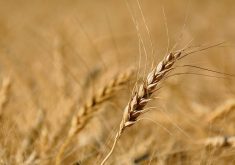Spraying wheat crops for midge after the crop has flowered is a waste of insecticide and may do more harm than good, even if wheat midge are still in the crop, Manitoba’s agriculture department warns.
That’s because when wheat flowers it changes chemically, and a substance called ferulic acid is produced. Ferulic acid makes the wheat an unsuitable host for wheat midge, said John Gavloski, the department’s extension entomologist at Carman, Man., in a memo to wheat growers on Friday. Larvae on the plant after ferulic acid is produced will starve to death.
Read Also

Senft to step down as CEO of Seeds Canada
Barry Senft, the founding CEO of the five-year-old Seeds Canada organization is stepping down as of January 2026.
Wheat midge can still be flying at night in large numbers in wheat fields that are at or past flowering. And they may still lay eggs on the heads. But larvae from these eggs will not be able to feed on the wheat and will starve, Gavloski wrote.
So there would be no reduction in wheat midge feeding by applying insecticide to a wheat field that has flowered, even if you are still seeing a lot of wheat midge in the field.
There is also a parasite, Macroglenes penetrans, that is very effective at reducing wheat midge numbers. Data from Saskatchewan have indicated that on average 30 to 40 per cent of the wheat midge population is killed by this parasite in a given year. Insecticides applied for wheat midge will kill this parasite, Gavloski warned.
So applying insecticides after flowering not only does not reduce wheat midge feeding, but kills off the parasite that hopefully will be reducing the population going into next year. So spraying may in fact be detrimental to long-term wheat midge management, he said.
Insecticides can be a valuable tool in wheat midge management, Gavloski said, but proper consideration of economic thresholds and crop staging is very important.















